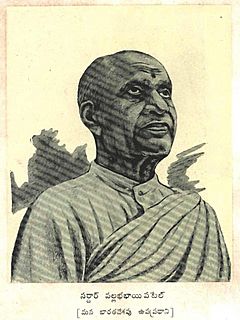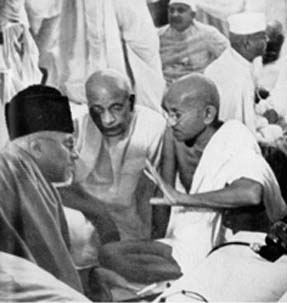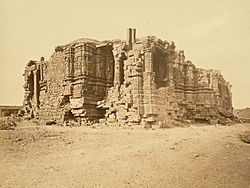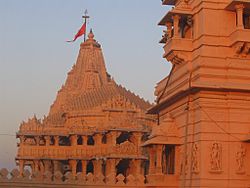Vallabhbhai Patel facts for kids
Quick facts for kids
Vallabhbhai Patel
|
|
|---|---|
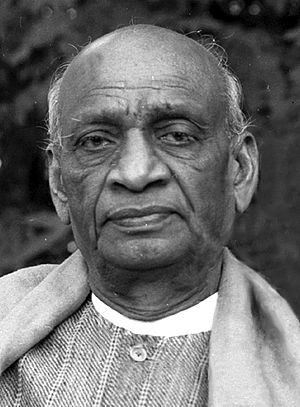
Sardar Patel in 1949
|
|
| 1st Deputy Prime Minister of India | |
| In office 15 August 1947 – 15 December 1950 |
|
| Monarch | George VI |
| President | Rajendra Prasad |
| Governor General |
|
| Prime Minister | Jawaharlal Nehru |
| Preceded by | Position established |
| Succeeded by | Morarji Desai |
| 1st Minister of Home Affairs | |
| In office 15 August 1947 – 15 December 1950 |
|
| President | Rajendra Prasad |
| Governor General | Louis Mountbatten |
| Prime Minister | Jawaharlal Nehru |
| Preceded by | Position established |
| Succeeded by | C. Rajagopalachari |
| Personal details | |
| Born |
Vallabhbhai Jhaverbhai Patel
31 October 1875 Nadiad, Bombay Presidency, British India |
| Died | 15 December 1950 (aged 75) Bombay, Bombay State, India |
| Political party | Indian National Congress |
| Spouse |
Jhaverben Patel
(m. 1891; died 1909) |
| Children |
|
| Relatives | Vithalbhai Patel (brother) |
| Alma mater | Middle Temple |
| Profession |
|
| Awards | Bharat Ratna (posthumous, 1991) |
Vallabhbhai Jhaverbhai Patel (31 October 1875 – 15 December 1950), often called Sardar Patel, was an important Indian leader. He was a lawyer and a politician. He served as India's first Deputy Prime Minister and Home Minister of India from 1947 to 1950.
Sardar Patel played a big part in India's fight for freedom. He helped unite India into one country after it became independent. People often called him Sardar, which means "chief" in many Indian languages. He was also known as the "Iron Man of India" because of his strong will.
Patel was born in Nadiad, Kheda district, in the state of Gujarat. He was a very good lawyer. He worked with Mahatma Gandhi and helped farmers in Gujarat protest against British rule peacefully. He became one of the most important leaders in Gujarat. He also became the president of the Indian National Congress and helped with elections. He supported the Quit India Movement.
As India's first Home Minister, Patel helped many people who had to move during the Partition of India. He worked hard to bring peace. He also united many small kingdoms, called princely states, with India. This was a huge task, and he did it very well. He also helped create the modern system of civil servants in India.
The Statue of Unity, the world's tallest statue, was built in his honor. It is in Gujarat and is about 182 meters (597 feet) tall. It was opened on 31 October 2018.
Contents
Early Life and Education
Vallabhbhai Jhaverbhai Patel was one of six children. He was born in Nadiad, Gujarat. His exact birth date was not recorded, but he used 31 October for his school exams. He came from the Leva Patel community.
Patel went to schools in Nadiad, Petlad, and Borsad. He learned to be strong and determined. There is a story that he treated his own painful boil without fear. When he finished school at 22, people thought he would have a normal job. But Patel wanted to become a lawyer. He planned to study in England to become a barrister.
He studied on his own, borrowing books from other lawyers. He passed his exams in two years. He married Jhaverba and they had a daughter, Maniben, in 1903, and a son, Dahyabhai, in 1905. Patel became a well-known and skilled lawyer.
In 1909, his wife Jhaverba became very ill and died in Bombay (now Mumbai). Patel was in court when he got the news. He read the note, put it in his pocket, and continued his work, winning the case. He told others only after the court session ended. Patel decided not to marry again. He raised his children with his family's help.
At 36, he went to England and studied law at the Middle Temple in London. He finished a three-year course in just 30 months. He was at the top of his class, even though he had not gone to college before.
After returning to India, Patel became a very successful lawyer in Ahmedabad. He dressed in European clothes and was a skilled bridge player. He wanted to grow his law practice and earn a lot of money. He also wanted to give his children a good education.
Fighting for India's Freedom
In 1917, Patel gave a speech in Borsad. He asked Indians to support Gandhi's call for Swaraj, which means self-rule from Britain. A month later, he met Gandhi for the first time. Gandhi encouraged him, and Patel became the secretary of the Gujarat Sabha. This group later became part of the Indian National Congress.
Patel worked hard against veth, which was forced labor for Europeans. He also helped people during a plague and famine in Kheda. The British government refused to lower taxes for the farmers in Kheda. Gandhi supported a protest there, but he was busy elsewhere. When Gandhi asked for someone to lead the protest, Patel volunteered. He decided to give up his law career for this important work.
Protests in Gujarat
Patel, with other volunteers, visited villages in Kheda. He listened to people's problems and asked them to support a tax strike. He told them it would be hard, but they needed to be united and peaceful. Almost every village agreed. When they stopped paying taxes, the government sent police to take their property. Patel set up a network of volunteers to help villagers hide their valuables. Many farmers were arrested, but Patel was not.
The protest gained support across India. The government finally agreed to talk. They suspended taxes for a year and even lowered the rate. Patel became a hero in Gujarat. In 1920, he became the president of the Gujarat Pradesh Congress Committee, a position he held until 1945.
Patel supported Gandhi's Non-cooperation movement. He helped recruit over 300,000 members and raised a lot of money. He even burned his own English-style clothes in public bonfires. He and his children started wearing khadi, which is Indian-made cotton clothing. Patel also worked against untouchability and caste discrimination. He also worked to empower women.
He was elected president of Ahmedabad's city council three times. He improved electricity, drainage, and sanitation in the city. He also reformed the school system. He helped teachers get paid and dealt with sensitive issues between Hindus and Muslims. In 1927, he led relief efforts after heavy floods in Ahmedabad and Kheda. He set up refugee centers and arranged for food, medicine, and clothes.
In 1923, Patel led a protest in Nagpur against a law that banned raising the Indian flag. He organized thousands of volunteers to break the law peacefully. Patel negotiated a deal that freed all prisoners and allowed people to hoist the flag. Later, he helped villagers in Borsad protest against a new tax. The government wanted to collect this tax to fight criminals. Patel showed that the police were working with the criminals. After a long struggle, the government removed the tax. Historians say Patel helped unite different groups and castes during these protests.
In 1928, Patel returned to the independence struggle. Bardoli was suffering from a famine and a big tax increase. Patel talked to villagers and started a complete refusal to pay taxes. The protest was very strong. Many people were arrested, and their property was taken. But the struggle grew. Finally, the government agreed to cancel the tax hike. They also gave back seized property. It was the women of Bardoli who first called him Sardar (chief) during this struggle.
Fundamental Rights and Economic Policy
In 1931, under Sardar Patel's leadership, the Congress passed a resolution on "Fundamental Rights and Economic Policy." This resolution supported basic rights and civil liberties. It also called for a secular nation, fair wages, and an end to untouchability.
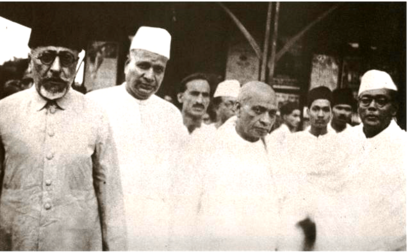
When Gandhi started the Dandi Salt March, Patel was arrested. He was put on trial without witnesses or lawyers. His arrest made the Salt Satyagraha even stronger in Gujarat. People refused to pay taxes until Patel and Gandhi were released. After his release, Patel became interim Congress president. He was arrested again while leading a march in Bombay.
After the Gandhi–Irwin Pact was signed, Patel was elected president of Congress for its 1931 meeting in Karachi. Here, Congress approved the pact and promised to protect fundamental rights. Patel used his position to help farmers in Gujarat get back their seized land.
In January 1932, Gandhi and Patel were arrested again and put in Yeravda Central Jail. They became very close during this time. They discussed national issues, read Hindu stories, and joked. Gandhi even taught Patel Sanskrit. Patel was deeply saddened when Gandhi's wife, Kasturba Gandhi, died later that year. Patel was released in July 1934.
From 1934, Patel played a key role in the Congress party. He became the main fundraiser and chairman of its Central Parliamentary Board. He helped choose and fund candidates for elections. He also decided the Congress's position on different issues. He guided Congress members who were elected to power.
Patel had surgery in 1935, but he continued to work. He directed efforts against the plague and a drought in Gujarat. He ensured party discipline among Congress ministries. He wanted to prevent the British from causing conflicts within the party. Patel disagreed with Jawaharlal Nehru about adopting socialism in 1936. He felt it was a distraction from gaining independence. In 1938, Patel led opposition against Subhas Chandra Bose, who was then Congress president. Patel felt Bose wanted too much power. This led to Bose's resignation.
Quit India Movement
When World War II started, Patel supported Nehru's decision for Congress to leave the legislatures. He also supported an offer to help Britain if they promised India independence. Gandhi had refused to support Britain due to his opposition to war. The British government rejected the offer. Patel then supported Gandhi's leadership again. He was arrested in 1940 and imprisoned for nine months. He also opposed the Cripps' mission proposals in 1942. Patel lost a lot of weight in jail.
While other leaders were unsure, Patel strongly supported Gandhi's idea for a big civil disobedience campaign. He believed the British would leave India, just as they had left Singapore and Burma. Patel urged that the campaign start right away. He felt a rebellion would unite Indians and force the British to give up control. Patel even said he would resign if the revolt was not approved.
Gandhi strongly pushed the All India Congress Committee to approve the campaign. It was approved on 7 August 1942. Even though his health was not good, Patel gave powerful speeches across India. He asked people to refuse to pay taxes, protest, and shut down services. He raised money and prepared other leaders in case the main leaders were arrested.
Historians believe Patel's speech inspired many nationalists. His organizing work helped the rebellion succeed across India. Patel was arrested on 9 August and imprisoned with other Congress leaders until 1945. In prison, he read, walked, and gardened. He also supported his colleagues. Patel was sad to hear about the deaths of Mahadev Desai and Kasturba Gandhi. But he wrote that he and his colleagues felt "fullest peace" for doing their "duty."
The Quit India movement was a very serious rebellion. More than 100,000 people were arrested, and many protesters were killed. Strikes and protests happened all over India. When Patel was released on 15 June 1945, he realized the British were preparing to transfer power to India.
India's Partition and Independence
In the 1946 elections, the Congress won most of the Hindu votes. However, the Muslim League, led by Muhammad Ali Jinnah, won most of the Muslim votes. The League wanted Pakistan, a separate state for Muslims.
Cabinet Mission and Partition
The British proposed two plans for transferring power. There was much disagreement within Congress. One plan suggested a loose federation of provinces. Another plan suggested dividing India based on religion. The League approved both plans, but Congress rejected the second one. Gandhi thought the second plan would divide people. But Patel realized that if Congress rejected it, only the League would be invited to form a government.
Patel talked with British envoys and got assurances that the "grouping" of provinces would not be forced. He convinced Jawaharlal Nehru, Rajendra Prasad, and C. Rajagopalachari to accept the plan. When the League changed its mind, the viceroy invited Congress to form the government. Nehru became the "Vice President," and Patel took charge of home affairs and information.
Patel was one of the first Congress leaders to accept the idea of dividing India. He was angry about Jinnah's Direct Action Day campaign, which caused violence. Patel believed that a divided government could lead to civil war. He also worried that many small kingdoms would try to become independent.
In late 1946 and early 1947, Patel worked on the idea of a separate dominion of Pakistan for Muslim-majority provinces. Violence in Bengal and Punjab convinced him that partition was necessary. Patel insisted on dividing Punjab and Bengal, preventing them from being fully included in Pakistan. Many Indians admired Patel for his strong stance. However, Gandhi, Nehru, and others criticized him for being too eager for partition. When Lord Louis Mountbatten formally proposed the plan on 3 June 1947, Patel approved it. He convinced Nehru and other Congress leaders to accept it. He talked to Gandhi about the practical problems of a joint government and the threat of civil war.
After Gandhi rejected the plan (but Congress approved it), Patel represented India on the Partition Council. He oversaw the division of public assets. However, no one expected the terrible violence and mass movement of people that followed partition. Patel led efforts to organize relief and refugee camps. He visited border areas with Pakistani leaders to encourage peace. Despite these efforts, hundreds of thousands of people died, and over 15 million became refugees.
Patel used the Indian Army to restore order in Delhi and Punjab. He imposed strict curfews. He visited areas where Muslims feared attacks and reinforced police presence. He stopped news reports of violence against Hindus and Sikhs in Pakistan to prevent more violence in India. Patel warned officials against being unfair. When he heard Sikhs were planning to attack Muslim convoys, he went to Amritsar. He told Sikh and Hindu leaders that attacking helpless people was wrong. He promised that if they kept peace, India would act strongly if Pakistan failed to protect minorities. After his speech, attacks on Muslim refugees stopped, and peace returned.
However, some leaders criticized Patel for his views on Muslims leaving India. Patel denied these claims. He clashed with Nehru and Maulana Azad over housing for refugees. Nehru and Azad wanted to give houses to displaced Muslims. Patel argued that a secular government should not make such distinctions. But Gandhi publicly defended Patel. Patel was admired for speaking frankly and acting decisively to stop violence.
Uniting Independent India
As the first Home Minister, Patel played the most important role in uniting the princely states with India. This is why he is remembered as the man who united India. He is compared to Otto von Bismarck, who united the German states.
Under the plan of 3 June, over 565 princely states could join India or Pakistan, or become independent. Indian leaders feared that if these states did not join, India would be broken into many pieces. Gandhi told Patel, "The problem of the States is so difficult that you alone can solve it." Patel was seen as the best person for this huge task. He asked V. P. Menon, a senior civil servant, to help him.
On 6 August 1947, Patel began talking to the princes. He invited them to his home for lunch and tea. He explained that there was no conflict between Congress and the rulers. He appealed to their patriotism, asking them to join India. He told them they could not stay independent. He offered them good terms, including special payments for their families. While encouraging them, Patel also made it clear that force could be used if needed. He set a deadline of 15 August 1947 for them to sign the agreement.
All but three states joined India willingly. Only Jammu and Kashmir, Junagadh, and Hyderabad did not join easily.
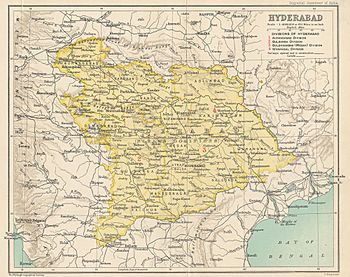
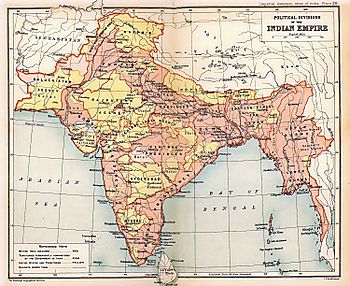
Junagadh was important to Patel because it was in his home state of Gujarat. It also had the rich Somnath temple. The ruler of Junagadh wanted to join Pakistan. But Junagadh was far from Pakistan, and 80% of its people were Hindu. Patel used both diplomacy and force. He sent the Army to occupy parts of Junagadh to show his resolve. The ruler fled, and the Indian Army entered the state. A vote later showed that 99.5% of people wanted to join India.
Hyderabad was the largest princely state. Its ruler, the Nizam Osman Ali Khan, was Muslim, but over 80% of his people were Hindu. The Nizam wanted independence or to join Pakistan. His loyal forces, called the Razakars, attacked people on Indian soil. Even though an agreement was signed, the Nizam kept changing his mind. In September 1948, Patel insisted that India should act. He convinced Nehru and the Governor-General to use military force.
Patel ordered the Indian Army to invade Hyderabad (while Nehru was away). This was called Operation Polo. Hyderabad was quickly secured and joined India. Patel wanted to prevent Hyderabad from remaining an independent area surrounded by India. After defeating the Nizam, Patel kept him as the ceremonial head of state. Sardar Patel united 562 princely states with India.
Leading India as a New Nation
The Governor-General of India, Chakravarti Rajagopalachari, along with Nehru and Patel, were the main leaders of India from 1948 to 1950. Prime Minister Nehru was very popular. But Patel had the loyalty of Congress members and civil servants. Patel was a senior leader in the Constituent Assembly of India and helped shape India's constitution.
Patel led committees for minorities, tribal areas, fundamental rights, and provincial constitutions. He helped create a model constitution for the provinces. He worked with Muslim leaders to end separate elections for minorities. He also helped protect civil servants from political interference. He was key in establishing the Indian Administrative Service and the Indian Police Service. He is known as the "patron saint" of India's civil services.
When farmers from Gujarat struggled to sell their milk, Patel told them to organize themselves. He guided them to create the Kaira District Co-operative Milk Producers' Union Limited, which led to the Amul milk brand. Patel also promised to rebuild the old Somnath Temple in Saurashtra. He oversaw the restoration and created a public trust.
When Pakistan invaded Kashmir in September 1947, Patel wanted to send troops immediately. But he waited until Kashmir officially joined India. Patel then oversaw India's military operations to secure Srinagar. He and Defence Minister Baldev Singh managed the entire military effort. Patel strongly advised Nehru against taking the issue to the United Nations. He believed Pakistan was wrong to support the invasion. Patel also opposed giving money to Pakistan, fearing it would fund the war in Kashmir. The Cabinet agreed with him, but Gandhi went on a fast to get the money released. Patel was hurt by this decision.
In 1949, many Hindu refugees came to West Bengal, Assam, and Tripura from East Pakistan. They were being forced out and faced violence. Nehru invited Pakistan's Prime Minister, Liaquat Ali Khan, to find a solution. Patel reluctantly met Khan. Patel criticized Nehru's plan for a pact to protect minorities in both countries. Two Bengali ministers resigned, and Nehru was criticized. But Patel publicly supported Nehru. He gave speeches and talked to many groups, asking them to give peace a chance.
In 2015, reports suggested that Patel and Nehru were involved in spying on Subhas Chandra Bose's family.
Father of All India Services
There is no alternative to this administrative system... The Union will go, you will not have a united India if you do not have good All-India Service which has the independence to speak out its mind, which has sense of security that you will standby your work... If you do not adopt this course, then do not follow the present Constitution. Substitute something else... these people are the instrument. Remove them and I see nothing but a picture of chaos all over the country.
Patel was very important in creating the All India Services. He called them the country's "Steel Frame." He told new civil servants to always be guided by service. He reminded them that the old British civil service was not good after Independence. He told them to be fair and honest. "A civil servant cannot afford to, and must not, take part in politics," he said on 21 April 1947.
He understood how important civil services are for running a country. They not only keep law and order but also hold society together. He knew India needed a strong and stable administration. The modern all-India administrative services exist because of his wisdom. That is why he is called the Father of modern All India Services.
Gandhi's Death and Relations with Nehru
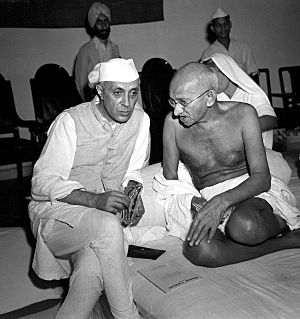
Rajmohan Gandhi wrote that Nehru focused on religious harmony, foreign policy, and industry. Patel focused on uniting the princely states, modernizing administration, and building agreement on the Constitution.
Patel was very loyal to Gandhi. Both he and Nehru looked to Gandhi to settle their disagreements. However, Nehru and Patel often argued about national issues. When Nehru took control of Kashmir policy, Patel felt his ministry was ignored. Nehru was upset by Patel's decisions on integrating the states. Patel asked Gandhi if he could leave the government. He thought an open fight would harm India. But Gandhi told Patel not to leave. He said a free India needed both Patel and Nehru.
Patel was the last person to talk privately with Gandhi. Gandhi was assassinated just minutes after Patel left. At Gandhi's funeral, Nehru and Patel embraced. They addressed the nation together. Patel comforted many people and quickly worked to prevent violence. Two months after Gandhi's death, Patel had a major heart attack. His daughter and others saved his life. Patel later said the attack was due to his grief over Gandhi's death.
Some media and politicians criticized Patel's ministry for failing to protect Gandhi. Patel was very tired and offered to resign. His secretary convinced him not to, as it would help his political enemies. Nehru wrote to Patel, saying there were no personal differences. He reminded Patel of their 30-year partnership. Nehru, Rajagopalachari, and others publicly defended Patel. Moved, Patel publicly supported Nehru's leadership. He denied any talk of disagreement or wanting to be prime minister.
Nehru gave Patel freedom to unite the princely states. They agreed to work together and not interfere in party matters. But they still sometimes criticized each other's policies. They disagreed on Hyderabad's integration and UN mediation in Kashmir. Nehru did not follow Patel's advice on helping Tibet after China invaded in 1950. He also disagreed on using military force to remove the Portuguese from Goa.
When Nehru pressured Rajendra Prasad not to become India's first President, the party was angry. Nehru wanted Rajagopalachari instead. Nehru asked Patel for help, but Patel refused. Prasad was elected President. Nehru opposed Purushottam Das Tandon for Congress president in 1950. He supported Jivatram Kripalani and threatened to resign if Tandon won. Patel disagreed with Nehru and supported Tandon. Patel believed Nehru needed to understand that his will was not law for Congress. But he personally told Nehru not to resign.
Views on RSS
The other is the R.S.S. I have made them an open offer. Change your plans, give up secrecy, respect the Constitution of India, show your loyalty to the (National Flag) and make us believe that we can trust your words. Whether they are friends or foes, and even if they are our own dear children, we are not going to allow them to play with fire so that the house may be set on fire. It would be criminal to allow young men to indulge in acts of violence and destruction..
In January 1948, Mahatma Gandhi was assassinated by Nathuram Godse. After the assassination, many leaders of the Hindu nationalist group Rashtriya Swayamsevak Sangh (RSS) were arrested. The organization was banned on 4 February 1948 by Patel. Patel said that "RSS men expressed joy and distributed sweets after Gandhi's death."
The RSS leaders were later found not guilty of conspiracy by the Supreme Court of India. After his release, M. S. Golwalkar, the RSS leader, asked Prime Minister Nehru to lift the ban. Nehru said it was the Home Minister's job. Golwalkar then talked to Vallabhbhai Patel. Patel demanded that the RSS create a formal, public constitution. He wanted them to promise loyalty to the Constitution of India, accept the Tricolor as the National Flag, define the leader's power, hold internal elections, get parents' permission for young members, and give up violence and secrecy.
Golwalkar protested this demand and was imprisoned again. Later, a constitution was written for the RSS. It was changed to meet most of Patel's demands. On 11 July 1949, the government lifted the ban on the RSS. This was because Golwalkar promised that the RSS would be loyal to the Constitution and respect the National Flag.
Final Years and Legacy
In his later years, Patel was honored by Parliament members. He received honorary law degrees from several universities in 1948 and 1949. He was also featured on the cover of Time magazine in January 1947.
On 29 March 1949, a plane carrying Patel, his daughter Maniben, and the Maharaja of Patiala lost radio contact. The pilot had to make an emergency landing in the desert in Rajasthan. Everyone was safe. Patel and others found a nearby village. When Patel returned to Delhi, thousands of Congress members welcomed him. In Parliament, members gave him a long standing ovation.
Death
Patel's health got worse in 1949. His daughter, Maniben, limited his meetings and work hours. She arranged for medical staff to care for him. He was flown to Bombay on 12 December for recovery. Nehru, Rajagopalachari, and others came to see him off. Patel was very weak and had to be carried onto the plane. In Bombay, large crowds gathered to greet him. To avoid stress, the plane landed at a different airport.
Patel died on 15 December 1950, at Birla House in Bombay, after a second major heart attack. The day after his death, over 1,500 civil and police officers gathered at his home in Delhi. They promised "complete loyalty" to India. Many world leaders sent their condolences.
Prime Minister Jawaharlal Nehru declared a week of national mourning. Patel's cremation was held in Sonapur, Bombay. It was attended by a million people, including Nehru and President Rajendra Prasad.
Legacy
In his speech after Patel's death, Girija Shankar Bajpai called him "a great patriot, a great administrator and a great man." Bajpai praised Patel for his role in making India stable after Independence and Partition.
Patel's daughter, Maniben Patel, lived in Bombay and worked for the Sardar Patel Memorial Trust. This trust organizes the annual Sardar Patel Memorial Lectures. His son, Dahyabhai Patel, was a businessman and later became a Member of Parliament.
For many years, there was not enough recognition for Patel's life and work. In 1991, he was given the Bharat Ratna, India's highest civilian honor, after his death. In 2014, his birthday, 31 October, was declared Rashtriya Ekta Diwas (National Unity Day). In 2012, he was ranked third in a poll of "the Greatest Indian."
Patel's family home in Karamsad is now preserved. The Sardar Vallabhbhai Patel National Memorial in Ahmedabad was opened in 1980. It has a museum, pictures, and a library about Patel's life.
Many public places in India are named after Patel. The Sardar Sarovar Project, a big project to build dams and power plants on the Narmada River, is named after him. Other places include the Sardar Vallabhbhai National Institute of Technology in Surat, Sardar Patel University, and the Sardar Vallabhbhai Patel National Police Academy.
The Sardar Vallabhbhai Patel International Airport in Ahmedabad is named after him. The international cricket stadium in Ahmedabad, also known as the Motera Stadium, is also named after him.
National Unity Day
Rashtriya Ekta Diwas (National Unity Day) was started by the Government of India in 2014. It is celebrated every year on 31 October, Patel's birthday. This day honors Patel, who was key in keeping India united. The Home Ministry says it helps "re-affirm the inherent strength and resilience of our nation."
National Unity Day celebrates Patel because he helped unite over 550 independent princely states with India from 1947 to 1949. He is known as the "Bismarck of India."
Commemorative Stamps
Commemorative stamps released by India Post (by year):
Statue of Unity
The Statue of Unity is a huge monument dedicated to Patel. It is in Gujarat, near the Narmada Dam. At 182 meters (597 feet), it is the tallest statue in the world. It cost about $425 million. India's Prime Minister Narendra Modi opened it on 31 October 2018.
Other Institutions and Monuments
- Sardar Patel Memorial Trust
- Sardar Vallabhbhai Patel National Memorial, Ahmedabad
- Sardar Sarovar Dam, Gujarat
- Sardar Vallabhbhai National Institute of Technology, Surat
- Sardar Patel University, Gujarat
- Sardar Patel University of Police, Security and Criminal Justice, Jodhpur
- Sardar Patel Institute of Technology, Vasad
- Sardar Patel Vidyalaya, New Delhi
- Sardar Vallabhbhai Patel National Police Academy, Hyderabad
- Sardar Patel College of Engineering, Mumbai
- Sardar Patel Institute of Technology, Mumbai
- Sardar Vallabhbhai Patel Chowk in Katra Gulab Singh, Pratapgarh, Uttar Pradesh
- Sardar Vallabhbhai Patel Institute of Technology, Vasad
- Sardar Vallabhbhai Patel International Airport, Ahmedabad
- Sardar Vallabhbhai Patel Police Museum, Kollam
- Sardar Patel Stadium
- Sardar Vallabhbhai Patel Stadium, Ahmedabad
- Sardar Vallabhbhai Patel University of Agriculture and Technology
- Vallabhbhai Patel Chest Institute
- Statue of Unity
- Sardar Vallabhbhai Patel University of Agriculture and Technology, Meerut
In Popular Media
- 1947: Patel was on the cover of Time magazine.
- 1976: Kantilal Rathod made a documentary about Sardar Vallabhbhai Patel.
- 1982: In the movie Gandhi, actor Saeed Jaffrey played Patel.
- 1993: The movie Sardar was made. Paresh Rawal played Patel. The film showed Patel's leadership before independence, the partition, and the uniting of India.
- 2000: Arun Sadekar played Patel in the film Hey Ram.
See also
 In Spanish: Sardar Vallabhbhai Patel para niños
In Spanish: Sardar Vallabhbhai Patel para niños


